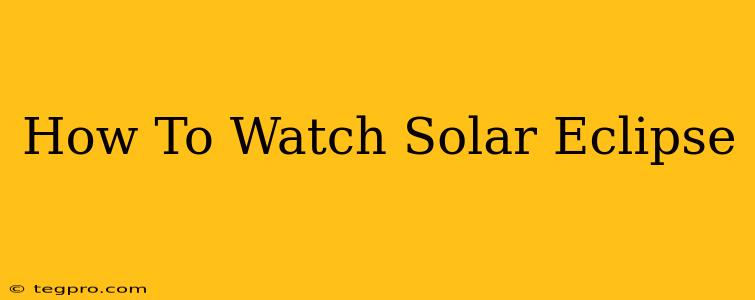Watching a solar eclipse is an awe-inspiring experience, but it's crucial to prioritize eye safety. Looking directly at the sun, even during an eclipse, can cause serious and permanent eye damage, including solar retinopathy. This guide will explain how to safely witness this celestial event.
Understanding the Dangers of Direct Sunlight
The sun emits incredibly intense radiation, including ultraviolet (UV) and infrared (IR) light. This radiation can damage the retina, the light-sensitive tissue at the back of your eye. Unlike other injuries, retinal damage from sun exposure often has no immediate pain, making it especially dangerous. The damage can be cumulative and lead to permanent vision loss or blindness. Never look directly at the sun without proper eye protection, even if the sun appears partially obscured during a partial eclipse.
Safe Solar Eclipse Viewing Methods
There are several safe ways to observe a solar eclipse:
1. ISO 12312-2 Certified Solar Eclipse Glasses: Your First Line of Defense
The most important piece of equipment for safe solar eclipse viewing is a pair of ISO 12312-2 certified solar eclipse glasses. These glasses are specifically designed to block out harmful solar radiation. Crucially, ensure your glasses meet this specific ISO standard. Ordinary sunglasses, even very dark ones, are not sufficient.
Tips for using solar eclipse glasses:
- Inspect your glasses carefully before use. Discard any that are scratched, torn, or otherwise damaged.
- Supervise children closely when they are wearing eclipse glasses.
- Keep your glasses on at all times while viewing the eclipse. Never remove them to glance directly at the sun.
2. Solar Filters for Telescopes and Binoculars
If you plan to view the eclipse through binoculars or a telescope, you must use a special solar filter designed for this purpose. These filters attach to the front of the optical instrument and significantly reduce the intensity of the sunlight before it reaches your eyes. Improperly using a telescope or binoculars without a solar filter can lead to severe eye injury or blindness.
3. Indirect Viewing Methods: Pinhole Projection
A simple and safe way to view the eclipse indirectly is through pinhole projection. This technique projects an image of the sun onto a surface.
How to Create a Pinhole Projector:
- Take a piece of cardboard and poke a small hole in the center using a pin or needle.
- Stand with your back to the sun.
- Hold the cardboard so that the sun shines through the hole.
- Observe the projected image of the sun on a second piece of cardboard or a white surface held several inches behind the first.
This method allows you to safely see the shape and progression of the eclipse without looking directly at the sun.
4. Watching the Eclipse Through a Live Stream
Many organizations and news outlets will broadcast live streams of the eclipse. This is a safe and convenient way to witness the event, especially if you are in an area with poor viewing conditions. This is a great option for those who don't have access to appropriate viewing equipment.
What Not To Do
- Do not use homemade filters: Homemade filters, such as smoked glass, are not safe and may still allow harmful radiation to reach your eyes.
- Do not look at the sun directly, even for a short time, without proper eye protection.
- Do not use sunglasses, even very dark ones. They are not designed to protect your eyes from the sun's intense radiation.
- Do not use binoculars or a telescope without proper solar filters.
Planning for Your Solar Eclipse Viewing
Remember to check the time and visibility of the eclipse in your location. Plan your viewing spot well in advance, ensuring you have a clear view of the sky. Bring comfortable seating, water, and snacks to make your viewing experience more enjoyable. With the proper precautions, you can safely witness this stunning celestial phenomenon.

